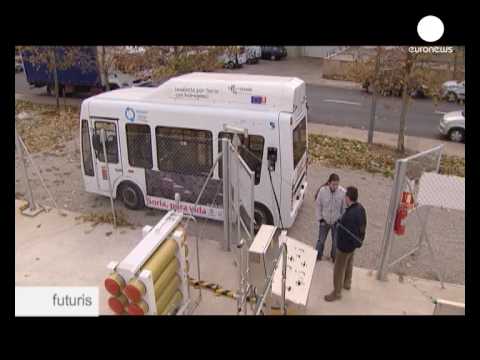Francisco Muñoz Tierno is 89 years old. A few months ago he retired from his farm to live in the calm and quiet of a care home in Soria, a Spanish provincial capital to the north-east of Madrid.
It is there that he became one of the first test drivers of a futuristic personal vehicle: a wheelchair powered by hydrogen fuel cell: “This wheelchair will be extremely useful for eldery and disabled people like me. It can travel a distance of many kilometres – that’s quite impressive!”
He revels in his new-found mobility. These ready-to-use prototypes are developed in the framework of a European project: “Hychain-Minitrans”, which aims to demonstrate the viability of pressurized hydrogen as an alternative fuel for city transportation. Currently being tested in real-life situations, such innovative devices are largely based on electric vehicles that already exist.
Wheelchair developer Alberto García Hombrados: “It’s a hydrogen energy system based on a fuel cell aboard the wheelchair, and consisting of two energy sources – the fuel cell and the battery array, that provide power for the wheelchair’s engine,” It only takes few minutes to replace an empty hydrogen canister with a full one to drive dozens of kilometres, whereas a full recharge of an electric vehicle takes several hours. “There are three major benefits: longer range – better than with conventional electrical wheelchairs; shorter recharging time – usually it takes up to 8 hours to recharge an electrical wheelchair and only 5 minutes for the hydrogen one; and lighter weight that simplifies transportation,” says Hombrados.
Soria, already investing in solar and wind energy infrastructures, is one of four European regions that is developing hydrogen transportation networks within the Hychain project. Another one is Nordrhein Westfallen in Germany. This former coal mine outside the town of Herten is being converted into a hydrogen technology centre. Here, another example of a personal hydrogen-fuelled vehicle is being developed: cargobikes, lightweight cargo transporting bicycles. Like the wheelchair, the cargobike gets its power from the fuel cell – a simple device that produces electric current when hydrogen reacts with oxygen in the air.
Bernard Krüsemann is laboratory manager for Masterflex, the cargobike’s developer: “The most important component of our system is the fuel cell – the so-called stack made of graphite plates, where hydrogen is directly converted into electrical energy without any further conversion steps and without any other complicated technology. It’s a very straightforward system.”
A fleet of cargobikes is going to be tested by a local telecommunications company. But, as we are about to see, hydrogen power is not limited to small personal vehicles. In the nearby town of Bottrop, bus line number 266 is served by a vehicle that produces no greenhouse gas emissions whatsoever. Like electric cars, the hydrogen bus moves silently, making none of the exterior noise typical of combustion engines. But you can still hear strange mechanical rumblings once inside.
Günter Bürmann is the bus’s driver: “The movement is so far quite rough and sometimes jittery, and some passengers say it’s quite noisy inside – but overall it’s very nice to drive.”
As opposed to smaller vehicles, the bus does not use exchangeable bottles of hydrogen to feed its batteries. Instead, developers have installed a gas tank that can be refuelled at special municipal filling stations. If hydrogen is to become a widely-used alternative car fuel in the decade to come, service stations will have to be equipped with hydrogen pumps. It will require a whole distribution network – an aspect also studied within the project.
Fernando Montañés works for Air Liquide España: “We can obtain this energy using clean renewable sources. But we need a complete infrastructure to make it accessible to the general public.”
But again, exactly how green will that be? Using hydrogen causes no pollution or greenhouse emissions, but industrial production has until now relied on exaustable resources. However there is hope that in the near future efficient production of clean hydrogen will become possible – based, for example, on electrolysis of water powered by solar energy. That would allow a significant cut in CO2 emissions , since pure water is the only byproduct of the hydrogen reaction with air within the fuel cell. So far such vehicles are not fast enough to drive on highways – but for urban cars top speed is not a priority anyway.
Antonio Bautista Sirvent is a vehicle maintenance specialist: “This vehicle has a range of about 100-120 kilometres and its maximum speed is about 50 km/h. These sort of cars are used inside cities, not to travel between them.”
But what about the safety issue? Surely carrying onboard bottles of pressurized hydrogen is too dangerous?
“In reality hydrogen isn’t any more dangerous than the gas we use every day domestically. The main issue is that it’s new to the general public, so everyone is concerned about it, but it’s just as safe as any other consumer gas,” assures Sirvent.
Advancing on hydrogen may help some of the emission-cutting obligations Europe has imposed on itself – but more efforts are needed to create a clean, safe and reliable transportation network on an international scale.
Back at the retirement home Francisco is learning how to drive his new toy: “This type of vehicle is very new for me – I have only spent a few minutes in it, so it’s no surprise I’m not that confident so far and need to stay focused to handle it”. Like with so many things in life, the hardest part is getting going.





